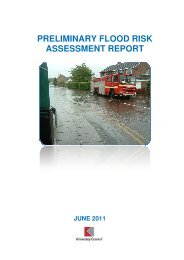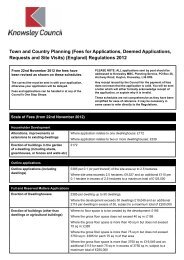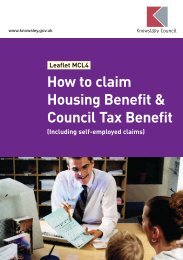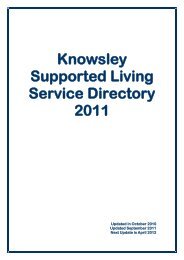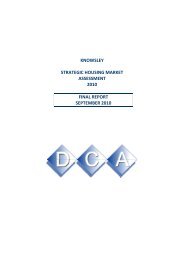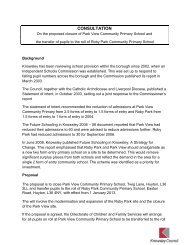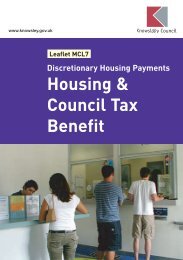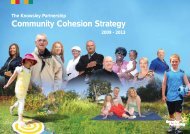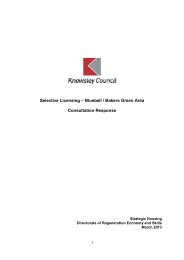Knowsley Replacement Unitary Development Plan - Knowsley Council
Knowsley Replacement Unitary Development Plan - Knowsley Council
Knowsley Replacement Unitary Development Plan - Knowsley Council
Create successful ePaper yourself
Turn your PDF publications into a flip-book with our unique Google optimized e-Paper software.
MINERALS, WASTE AND ENERGY<br />
MINERALS, WASTE AND ENERGY<br />
Table 12.1<br />
Table 12.2<br />
POLICY LINKS<br />
Mineral <strong>Development</strong>s - Matters to be included in<br />
Operations Statements<br />
Applicants will need to show (in no particular<br />
order in minerals applications) how the likely<br />
impacts of the development on the following<br />
matters will be mitigated:<br />
• The effect of the development on existing or<br />
proposed residential or other environmentally<br />
sensitive uses in terms of: visual amenity;<br />
dust, smells, air, land or water pollution; noise<br />
and vibration; and floodlighting.<br />
• The likely effect on areas of: recreational use;<br />
landscape; ecological importance; and<br />
archaeological interest.<br />
• The impact of operations on the structural<br />
integrity or setting of a Listed Building or<br />
Conservation Area and Scheduled<br />
Ancient Monuments.<br />
• The impact on groundwater and surface<br />
water resources; including pollution, flows<br />
of floodwater or the capacity of flood<br />
storage areas.<br />
• The hours of working;<br />
• Blasting and gas flaring requirements;<br />
• The estimated number of vehicle movements<br />
each week;<br />
• Details of maintenance regimes for plant<br />
and equipment;<br />
• Assessment of the likelihood of borrow pits<br />
being required off-site;<br />
• Facilities for sheeting and washing vehicles<br />
leaving the site;<br />
• How soil that is removed as part of operations<br />
will be protected and retained;<br />
• The height of stock piles;<br />
• How mineral waste will be disposed of and<br />
processed; and<br />
• The measures that will be taken to identify,<br />
safeguard and, where appropriate, enhance<br />
features of landscape, ecological,<br />
archaeological or earth science interest<br />
existing on site or created by workings.<br />
Mineral <strong>Development</strong>s - Matters to be included in<br />
Restoration and Aftercare <strong>Plan</strong>s<br />
All minerals developments must leave the site and<br />
adjacent land in a condition which is safe, stable,<br />
adequately drained and restored to the required<br />
landform, to a standard suitable for the agreed<br />
after use.<br />
The restoration and aftercare statement should<br />
cover the following:<br />
• Stripping of soils and soil making materials,<br />
storage and/or direct replacement;<br />
• Storage and replacement of overburden;<br />
• Achieving the landscape and landform<br />
objectives for the site, including filling<br />
operations if required following minerals<br />
extraction;<br />
• Restoration including soil placement, relief of<br />
compaction and provision of surface features;<br />
• How the site will be made stable, adequately<br />
drained and restored to the required landform,<br />
to a standard suitable for the agreed after use;<br />
Policy G1<br />
“<strong>Development</strong> within the Green Belt”<br />
Policy G2<br />
“Landscape Character and Amenities of the Green<br />
Belt”<br />
Policy G3<br />
“Agricultural Land”<br />
Policy G4<br />
“Rural Diversification”<br />
Policy DQ5<br />
“<strong>Development</strong> in Conservation Areas”<br />
Policy DQ7<br />
“Listed Buildings”<br />
Policy DQ9<br />
“Sites and Areas of Archaeological Importance”<br />
Policy ENV1<br />
“Control of Pollution in New <strong>Development</strong>”<br />
Policy ENV2<br />
“Noise and Vibration”<br />
Policy ENV3<br />
“Light Pollution”<br />
• The impact on the structure or viability of<br />
agricultural holdings and loss or reduction in<br />
agricultural land quality including best and<br />
most versatile agricultural land.<br />
• Availability of suitable filling materials for<br />
restoration and the feasibility of achieving the<br />
proposed restoration within an acceptable<br />
timescale using imported material;<br />
Policy ENV9<br />
“Protection of Habitats and Designated Sites”<br />
Policy ENV10<br />
“Protection of Species”<br />
• The impact on the stability and drainage of the<br />
site and adjacent land.<br />
• Phasing of restoration; means of incorporating<br />
new wildlife habitats; agreed after use.<br />
Policy T8<br />
"Transport Assessments"<br />
• The impact of traffic generated by the<br />
development on properties on adjoining<br />
routes used by the operations or on safety<br />
anywhere between the site and the strategic<br />
transport network. Where possible,<br />
sustainable alternatives to road transport<br />
should be employed.<br />
12.18<br />
The <strong>Council</strong> may adopt a Supplementary <strong>Plan</strong>ning<br />
Document which will indicate in greater detail the<br />
matters to be included in planning applications.<br />
Policy T12<br />
“Aerodrome Safeguarding”<br />
Details on the following should also be included<br />
within the statement:<br />
• Access to the site;<br />
• The duration of operations;<br />
• The phasing of operations;<br />
142<br />
KNOWSLEY REPLACEMENT UNITARY DEVELOPMENT PLAN: Adopted June 2006<br />
KNOWSLEY REPLACEMENT UNITARY DEVELOPMENT PLAN: Adopted June 2006<br />
143



